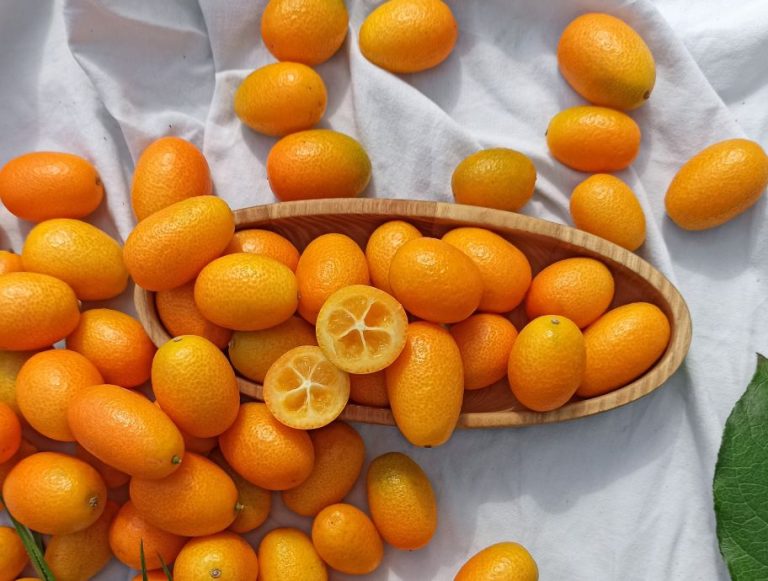Kumquats are small, orange fruits that have a sweet and tart aroma. The “dwarf oranges” originally come from Asia, but they also thrive here. You can find out how to plant and eat kumquats here.
Kumquats are also called dwarf oranges because they are very similar in color to traditional oranges. However, with a maximum length of five centimetres, they are significantly smaller and more pear-shaped to egg-shaped than round.
Properties of the kumquat plant

Growth: Kumquats grow on an evergreen shrub or small tree that can grow up to 15 feet tall. If the shrub is in a bucket, it will be a maximum of one and a half meters high. The branches can sometimes have small thorns and bear white flowers in spring.
Yield: A mature tree can produce several hundred to several thousand fruits per year. The fruits are edible and have a sweet and sour taste.
Origin: The kumquat tree originally came from Asia, but today it is also cultivated in America, Africa and in warm southern European locations, such as Corfu.
But you can also grow kumquats at home. So you can enjoy the fruit without having to travel long distances that cause a lot of CO2 emissions. However, kumquats are not the most resource-efficient plants either: They need water every day in summer and also have to be fertilized regularly.
Plant kumquats
Kumquats are exotic fruits that come from a warm climate. Accordingly, they are not hardy and do not grow well outdoors. A bucket is better because the shrub can be outside in summer and move to winter quarters in autumn.
You can grow kumquat bushes from seed, but then you’ll have to wait a few years for the first fruit. The first harvest is quicker if you buy a pre-grown shrub from a garden store. In order to avoid long transport routes, you can make sure that the shrub comes from Europe if possible or was grown locally in specialist shops.
Location:
Kumquats need sun and warmth. Therefore, you should choose a bright location where the shrub gets as much direct sunlight as possible. For example, conservatories, balconies and terraces are good if they are on the south side of the house. The kumquat shrub should be in a wind-protected corner and protected from drafts.
Planting:
The kumquat shrub thrives best in very nutrient-rich soil mixed with plenty of compost. Calcareous soils are unsuitable.
So that the soil does not become too compact but remains permeable to water, you should add some leaf soil or peat substitute. Read more: Peat-free soil: why peat is a problem. In another article we will show you how to make peat-free soil yourself.
Your planter should be about an inch larger in diameter than the one you purchased the shrub in. The jar should have a drainage hole. Lay stones or shards of pottery over the hole so that the water can drain off easily.
Cover the potsherds or stones with some soil and then plant the shrub. Fill the container with soil and water the shrub well. But make sure that no waterlogging forms.
Caring for and overwintering kumquats
Care
Watering: From spring to autumn, the kumquat bush needs plenty of water. It can also be watered again when the soil is still a little damp. In extreme heat, it may need water every day. Rainwater or low-lime tap water is best.
Fertilizer: In the growth phase (mid-April to the end of August), the shrub needs fertilizer regularly. You can mix some mineral fertilizer into the soil about once a week, and occasionally add some organic fertilizer as well.
Repotting: Every two to three years you should replant the shrub into a pot that is about four centimeters larger. Spring is best for repotting, before the shrub sprouts again.
Hibernate
Although kumquats do not like frost, they can withstand slightly below zero. Nevertheless, they should be brought indoors over the winter, from the beginning or middle of November, depending on the region. A bright place with temperatures between five and ten degrees Celsius is suitable. That would be, for example, bright garages, frost-free greenhouses or unheated conservatories and hallways.
In the winter quarters you do not have to fertilize the kumquat shrub and only water it sparingly when the soil is superficially dry.
Hibernation ends at the beginning of April. The transition to the outside should be done carefully. Choose an overcast day to put the shrub outside again, otherwise it could get sunburned.
Harvesting and eating kumquats

You can simply pick kumquats from the bush as soon as they have turned a beautiful golden yellow to dark orange colour.
The fruits have a sweet skin and sour flesh, so they taste especially good if you eat the skin as well. To intensify the sweet taste, you can rub the kumquat back and forth between your fingertips and apply light pressure to the skin. In this way, the aromatic substances in it are released better.
You can easily pull off or cut off the base of the stem. Inside are the seeds of the fruit. They have a bitter taste. If you don’t like this one, you can cut the kumquat in half and remove the seeds before eating the fruit.
The fruits are not only suitable for direct consumption, but also taste good when you cook jam with them.


